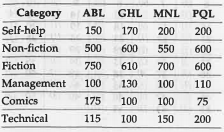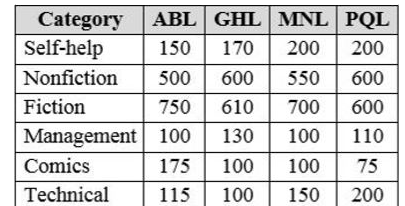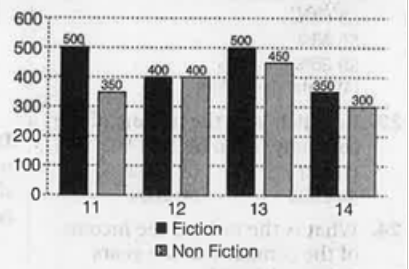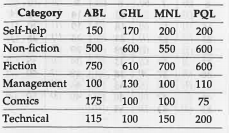In 2010, a library contained a total of 11500 books in two categories fiction and non-fiction. In 2015, the library contained a total of 12760 books in these two categories. During this period, there was 10% increase in the fiction category while there was 12% increase in the non-fiction category. How many fiction books were in the library in 2015?
6600
6160
6000
5500
The correct Answer is:A
Step by step video, text & image solution for In 2010, a library contained a total of 11500 books in two categories fiction and non-fiction. In 2015, the library contained a total of 12760 books in these two categories. During this period, there was 10% increase in the fiction category while there was 12% increase in the non-fiction category. How many fiction books were in the library in 2015? by Maths experts to help you in doubts & scoring excellent marks in Class 14 exams.
Topper's Solved these Questions
- BOOK - GAGAN PRATAP CHAPTER - PERCENTAGEEXERCISE - Percentage (Sheet-3)38videos
PERCENTAGE
- BOOK - GAGAN PRATAP CHAPTER - PERCENTAGEEXERCISE - Percentage (Sheet-4)35videos
PERCENTAGE
- BOOK - GAGAN PRATAP CHAPTER - PERCENTAGEEXERCISE - Percentage (Sheet-4)35videos
PERCENTAGE
- BOOK - GAGAN PRATAP CHAPTER - PARTNERSHIPEXERCISE - Multiple Choice Questions41videos
PARTNERSHIP
- BOOK - GAGAN PRATAP CHAPTER - PIPE & CISTERNEXERCISE - MULTIPLE CHOICE QUESTION46videos
PIPE & CISTERN
Similar Questions
The following table represents the category wise count of books in four local libraries.

The difference between the total number of non-fiction and management books of all four libraries isView SolutionThe following table represents the category wise count of books in four local libraries.

The self help books in library GHL is how much less its fictional booksView Solution
Knowledge Check
- Question 1 - Select One
Comprehension:
The following table represents the category wise count of books in four local libraries.

Consider the table and answer questions based on it.
The difference between the total number of nonfiction and management books of all four libraries is
A. 1850
B. 1810
C. 2250
D. 1800AABCCDDB - Question 2 - Select One
Comprehension:
The following table represents the category wise count of books in four local libraries.

Consider the table and answer questions based on it.
The difference between the total number of nonfiction and management books of all four libraries is
A. 1850
B. 1810
C. 2250
D. 1800AABCCDDB - Question 3 - Select One
In 18th-century Germany, Baron Munchausen regales his friends, over drinks, with stories of his many adventures. These include his supposed travel to the moon. Long before Neil Armstrong and Edwin Aldrin stepped out of Apollo 11 onto the surface of the moon 50 years ago, on July 20, 1969, the aspiration to travel to this shiny orb in the sky has fired human imagination. A Flight T o The Moon by George Fowler, From The Earth To The Moon – and its sequel, Around The Moon – by Jules Verne, The First Men In the Moon by HG Wells, Prelude To Space by Arthur C Clarke… are o nly a few of the many fictionalised accounts that have, for centuries, reflected this aspiration. In the 1954 Explorers On The Moon, i conic comic book character, Tintin, reaches the moon. While some writers imagined the moon’s surface to be barren and uninhabited, others have written about it being populated with lunar beings. Even when Apollo 11 mission was being planned and worked on, in 1963, Apollo At Go by Jeff Sutton, presented a realistic fictionalised portrayal of the upcoming landing. The successful landing of Apollo 11 and Neil Armstrong and Buzz Aldrin’s walk on the moon, opened up another exciting possibility – could the common m an or non-space-scientist reach for the moon? Literally? What had hitherto been in the realm of speculation was now a reality and we weren’t satisfied with just second-hand information any more. Between 1969 and 1972, the US sent six successful manned missions to the moon, and with each victory, the lunar destination seemed a little closer within the reach of the common man.
How many fictional books written about t ravelling to the moon are referred to heASevenBSixCEightDFive
The bar chart represents number of fiction and non-fiction books in four libraries L1, L2, L3 and L4 comsider the bar chart and answer questions based on it.

What is the percentage difference of total number of fiction books in libraries L3 and L4 to the Non Fiction books in L3 and L4.View SolutionRatio of the fares of First ,Second and Third class catogory of a train , between two stations is 10:7:2 and the ratio of passenger travelling in these category is 4:9:17 respectively .If the fare is increased by 1/4 in First class , 1/8 in second class and decreased by 10% i Third Class and the ratio of number of passenger in the category remains same .If the total amount received of Rs. 60590 , then find the total amount received from thrid class category .
View SolutionThe following table represents the category wise count of books in four local libraries.

Which library has the highest total count of books?View SolutionRead the passage and answer the questions given below it.
In 18" century Germany, Baron Munchausen regales his friends, over drinks, with stories of his many adventures. These include his supposed travel to the moon. Long before Neil Armstrong and Edwin Aldrin stepped out of Apollo 11 onto the surface of the moon 50 years ago, on July 20, 1969, the aspiration to travel to this shiny orb in the sky has fired human imagination. A Flight To The Moon by George Fowler, From The Earth To The Moon - and its sequel, Around The Moon - by Jules Verne, The First Men In The Moon by HG Wells, Prelude To Space by Arthur C Clarke... are only a few of the many fictionalised accounts that have, for centuries, reflected this aspiration. In the 1954 Explorers On The Moon, iconic comic book character, Tintin, reaches the moon. While some writers imagined the moon.s surface to be barren and uninhabited, others have written about it being populated with lunar beings. Even when Apollo 11 mission was being planned and worked on, in 1963, Apollo At Go by Jeff Sutton, presented a realistic fictionalised portrayal of the upcoming landing.
The successful landing of Apollo 11 and Neil Armstrong and Buzz Aldrin.s walk on the moon, opened up another exciting possibility - could the common man or non-spacescientist reach for the moon? Literally? What had hitherto been in the realm of speculation was now a reality and we weren.t satisfied with just second-hand information any more. Between 1969 and 1972, the US sent six successful manned missions to the moon, and with each victory, the lunar destination seemed a little closer within the reach of the common man.
How many fictional books written about travelling to the moon are referred to here?View SolutionAnswer the questions on the basis of the information given below: Coach John sat with the score cards of Indian players from the 3 games in a one-day cricket tournament where the same set of players played for India and all the major batsman got out. John summarized the batting performance through three diagrams, one for each game. In each diagram, the three outer triangles communicate the number of runs scored by the three top scorers from India, where K, R, S,V and Y represent Kaif, Rahul, Saurav, Virender, and Yuvraj respectively. The middle triangle in each diagram denotes the percentage of total score that was scored by the top three Indian scorers in that game. No two players score the same number of runs in the same game. John also calculated two batting indices for each player based on his scores in the tournament, the R-index of a batsman is the difference between his highest and lowest scores in the 3 games while the M-index is the middle number, if his scores are arranged in a non-increasing order.

For how many Indian players is it possible to calculate the exact M-index?View Solution
